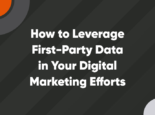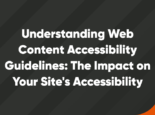
Why Accessibility Should Be a Top Priority for Every Business Website

This post was originally published in April 2018 and has since been updated to reflect current information and WCAG updates.
Imagine how frustrating it would be to land on a website you couldn’t use. That’s what over 57 million people experience every day when visiting websites that seem to have decent enough UX/UI. Websites just like yours that look great, convert well, and cost your company a lot of money.
98% of websites don't comply with the Web Content Accessibility Guidelines version 2.1, which is the current standard for ADA compliance on the web. Just 2% of websites are fully accessible, with 1 in 4 Americans experiencing some level of difficulty using almost every site on the web. We're currently a long way from a fully accessible web.
ADA compliance and web accessibility are necessary if you want to fully maximize your reach, protect your business from harmful litigation, and most importantly, make the internet a better, more accessible place for all users.
One of the biggest objections that businesses have historically had against ADA compliance and web accessibility is the cost of reaching compliance – and staying up-to-date on the latest Web Content Accessibility Guidelines as they're continuously changing. But now, with technologies like accessiBe, there are simpler ways to achieve compliance that don't cost a fortune.
There are many reasons why you should activate a web accessibility plan for your business – and it's never been easier to make it happen.
Why is digital accessibility important?
When the Americans with Disabilities Act (ADA) was originally passed as a civil rights law in 1990, it focused on combatting discrimination in all areas of public life. At the time, that primarily meant public and private spaces, like schools, restaurants, transportation, etc.
As the internet has grown, people are continuing to spend more time online. Think about how much time you spend shopping, researching, communicating, and engaging with content online. The internet is integrated into so many facets of our lives, which makes creating inclusive spaces online that all users can access incredibly important.
Web accessibility guidelines apply to so many different situations and disabilities, including:
- Visual
- Physical
- Speech
- Auditory
- Language
- Cognitive
- Learning
- Neurological
Why is accessibility important in web design?
Web design plays a major role in improving accessibility. When website designers, developers, and digital marketers pay attention to the guidelines set out by WCAG, they’re paving the way for websites that anyone can use.
There are many factors that go into creating an accessible website, but paying close attention to colors, user experience, and font sizes are some key aspects of accessible web design.
The benefits of having a web accessibility plan in place
Aside from the obvious benefit of contributing to a better, more accessible internet, prioritizing accessibility compliance comes with plenty of business benefits, too. Take a look at the top three:
1. Reach all of your customers
You probably have a good idea who your target customer is, and you probably designed your current website with that customer in mind. But you probably didn’t consider the high probability that your target audience includes a lot of customers with accessibility needs. There are over 57 million disabled individuals in the United States alone. The disability market has over $1.2 trillion in spending power. That’s a lot of customers and a lot of money you’re losing if your website isn’t accessible.
From a revenue standpoint, you can’t afford to miss these customers. 71% of disabled customers will immediately abandon a site that isn’t accessible, and they’ll never return. But money aside, you want to be able to provide your products and services for all your potential customers because that’s why you’re in business to begin with. Right now, you simply can’t do it because your website isn’t accessible.
Every business has customers with accessibility needs
Some businesses may be tempted to discount this market with sweeping statements like “but disabled individuals don’t use our products or services.” This is categorically false. Every business has disabled customers. Unfortunately, there’s no data in analytics that shows how many disabled customers are visiting your website, so it can be difficult to see how much money you’re losing by having a non-accessible website. To really understand just how much this can impact your business, it’s essential to understand the wide range of disabilities covered by ADA and addressed by WCAG.
Roughly 20% of Americans have a vision, physical, cognitive, or auditory disability. Your website needs to be accessible to everyone whether they’re color blind or physically unable to use a mouse or keyboard. No business can say, “But none of my customers are color blind, in a wheelchair, or partially deaf.” And that only covers a small sliver of the disabilities that require accessibility on the web.
Accessibility isn’t something you can pick and choose. It needs to be done right so you can reach every customer regardless of their disability. You might think you can cut some corners because you’re confident that a quadriplegic has no use for your products or services. This is the type of discrimination that not only can cost you a customer, but it can also lead to a lawsuit against your business.
2. Take advantage of industry gaps
Are other businesses in your industry providing accessible experiences on their websites, or is the industry lacking opportunities for people with disabilities to engage? Start prioritizing accessibility in your own business to reach people you couldn’t before.
Many users with accessibility needs depend entirely on the internet to get their shopping done. If your site is one of the few in your industry that offers a user-friendly experience that accommodates their specific disability, then you’ve gained more than a lifelong customer. You’ve gained a loyal brand advocate.
3. Avoid expensive litigation
Lawsuits can cost your business a lot of time and money. They can also hurt your reputation or even force you to shut down entirely. The number of website accessibility lawsuits has steadily increased by an average of 13% year over year since 2019. And no business sector is immune to getting served with a demand letter for having an inaccessible website.
Accessibility litigation is by no means a new thing. Bank of America was the first victim, settling a web-accessibility lawsuit back in 2000. The first major class-action lawsuit in the U.S. was brought against Minneapolis-based Target in 2008. The damage was $6 million plus another $3.7 million in legal fees. Three years later, Wells Fargo paid out $16 million after a similar lawsuit was filed. Things are really ramping up now. There have been tens of thousands of demand letters, and lawyers are pursuing companies of all sizes with accessibility litigation.
And settling lawsuits of this nature typically ranges from $3,000-$23,000 or more. Definitely not something to mess around with.
Every business is a potential target
Of course, you’re probably thinking that no one will come after you. You’re not a Fortune 500 company, so it’s not worth the lawyer’s time to pursue you. In a lawyer’s mind, that makes you an easy target. You might not have to fork over millions, but you’ll be a good candidate for a quick settlement that will put a huge strain on your business.
Thus far, the industries most impacted are banking, e-commerce, dining, medical, and hospitality. However, lawsuits have permeated into all markets, and no business is exempt regardless of size. You either need to budget for website accessibility or for an accessibility lawsuit. Investing in website accessibility is going to be much better for your business in the long run.
The cost of an accessible website
We don’t mean to scare you with potential lawsuits and threats to your business. And really, there’s no need to be scared. With new technology powered by AI, it’s never been this simple and affordable to ensure your website complies with WGAC 2.1.
accessiBe, an AI-powered accessibility software that can integrate with your website to offer users options for how they experience your website, is an affordable and effective option for making your site more accessible. Plus, rather than paying thousands of dollars to upgrade your website and make sure it's compliant, you can pay a monthly fee for continuous site upgrades that occur automatically through the accessiBe widget. These types of solutions make accessibility much more attainable for companies of all sizes and budgets.
What’s next in website accessibility?
The current global court-accepted standard for web compliance is WCAG 2.1. To avoid litigation and ensure your site is available to all users, you should focus on making sure your site is compliant with 2.1. The next set of guidelines is already in process, with WCAG 2.2 on the horizon.
All of this may seem overwhelming – you have to not only ensure your website fully complies with WCAG 2.1, but you also have to be prepared to shift over to 2.2 compliance once those guidelines go into effect.
The accessiBe widget that we mentioned above will provide ADA compliance on your site with the current 2.1 guidelines, and once we shift to 2.2, the widget will provide compliance for those guidelines too. Using a tool like accessiBe to ensure your site is usable for all visitors makes your life easier in not having to hire experts to make expensive alterations to your site and conduct user testing when new guidelines go into effect. Instead, you can rely on accessiBe to proactively make those changes for you.
Whether or not you choose to implement a tool like accessiBe, you should consider the current guidelines and determine the best way to ensure your website is fully compliant.
Begin to prioritize website accessibility
Every day you wait to pursue website accessibility means more lost customers and a greater chance for expensive litigation. Web accessibility shouldn’t be viewed as another expense for your business. Rather, it should be viewed as an opportunity to expand your customer base and protect your business. Even more importantly, it’s an opportunity to make the internet a better place for everyone.
And now, with accessiBe, it's never been easier to ensure your website is ADA compliant so you can rest easy knowing all of your users are able to engage with your site. And as an accessiBe partner, we're here to help you implement accessiBe on your site.
Have questions about web accessibility and what you need to do to be ADA compliant? Contact us today to learn more about how we can help evaluate your site and get accessiBe implemented.

Nate Tower
Nate Tower is the President of Perrill and has over 12 years of marketing and sales experience. During his career in digital marketing, Nate has demonstrated exceptional skills in strategic planning, creative ideation and execution. Nate's academic background includes a B.A. with a double major in English Language and Literature, Secondary Education, and a minor in Creative Writing from Washington University. He further expanded his expertise by completing the MBA Essentials program at Carlson Executive Education, University of Minnesota.
Nate holds multiple certifications from HubSpot and Google including Sales Hub Enterprise Implementation, Google Analytics for Power Users and Google Analytics 4. His unique blend of creative and analytical skills positions him as a leader in both the marketing and creative worlds. This, coupled with his passion for learning and educating, lends him the ability to make the complex accessible and the perplexing clear.



